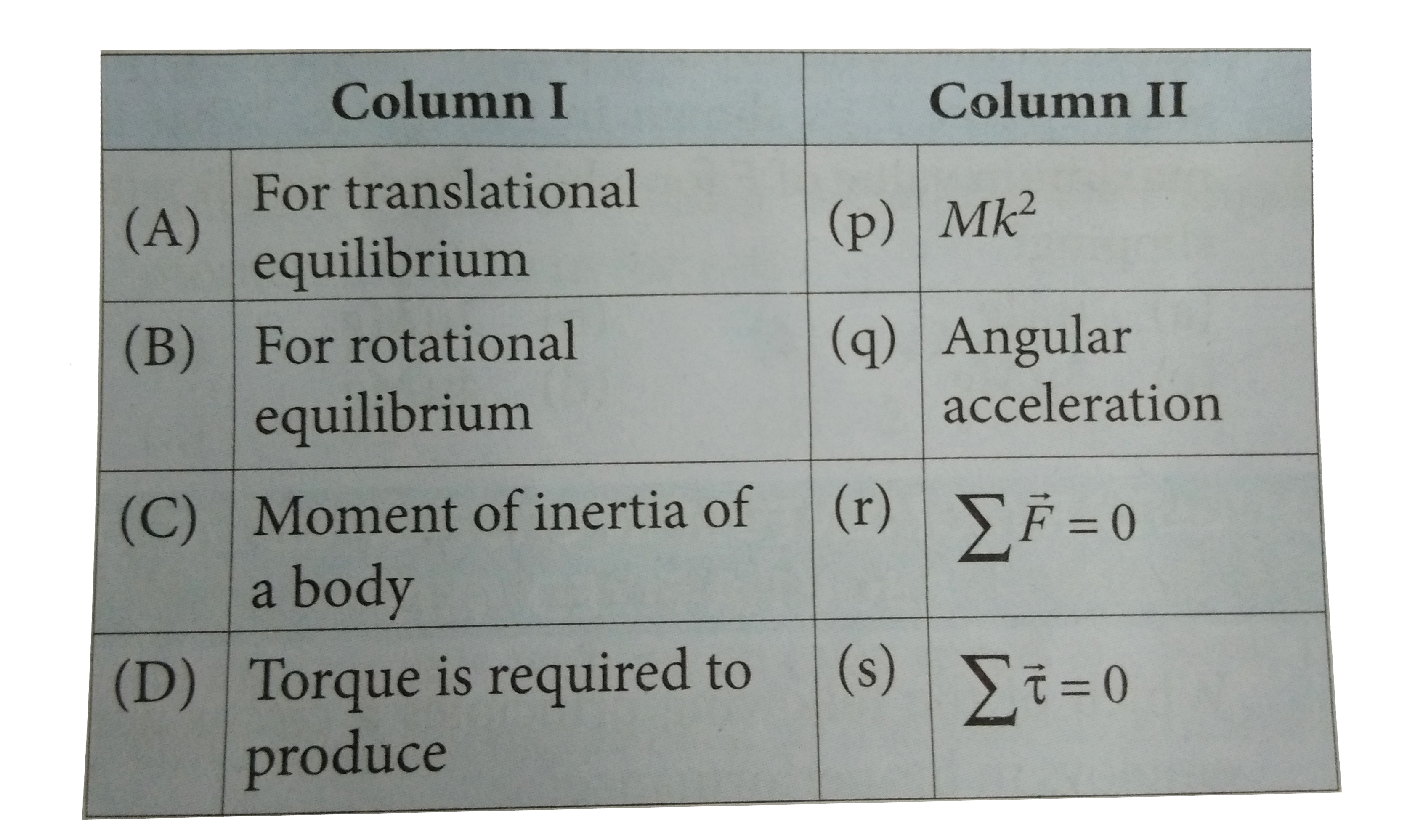Match the columns
Column I Column II(i)Chondrocyte(a)Bone forming (ii)Osteocyte(b)Cartilage forming(iii)Osteoblasts(c)Bone maintaing(iv)Osteoclast(d)Bone eating
(i) -(a) , (ii) - (b) , (iii) - (c) , (iv) - (d)
(i) - (b) , (ii) -(d) , (iii) - (c) , (iv) - (a)
(i) - (b) , (ii) -(c), (iii) - (a), (iv) - (d)
(i) - (d) , (ii) - ( b) , (iii) - (a) , (iv) -(c).
The correct Answer is:C
To solve the matching question, we need to identify the correct pairs between the cells listed in Column I and their corresponding functions or characteristics in Column II. Let's analyze each cell type step by step.
1. Chondrocyte:
- Definition: Chondrocytes are the cells found in cartilage.
- Function: They are responsible for the formation and maintenance of cartilage by secreting the extracellular matrix.
- Match: Therefore, the correct match for chondrocyte is (i) Chondrocyte - (b) Cartilage forming.
2. Osteocyte:
- Definition: Osteocytes are mature bone cells derived from osteoblasts.
- Function: They play a crucial role in maintaining bone tissue and sensing mechanical stress.
- Match: Thus, the correct match for osteocyte is (ii) Osteocyte - (c) Bone maintaining.
3. Osteoblasts:
- Definition: Osteoblasts are bone-forming cells that synthesize new bone matrix.
- Function: Their primary role is to produce new bone tissue.
- Match: Hence, the correct match for osteoblasts is (iii) Osteoblasts - (a) Bone forming.
4. Osteoclast:
- Definition: Osteoclasts are large, multinucleated cells involved in bone resorption.
- Function: They break down bone tissue, which is often referred to as "bone eating."
- Match: Therefore, the correct match for osteoclast is (iv) Osteoclast - (d) Bone eating.
Final Matches:
- (i) Chondrocyte - (b) Cartilage forming
- (ii) Osteocyte - (c) Bone maintaining
- (iii) Osteoblasts - (a) Bone forming
- (iv) Osteoclast - (d) Bone eating
Summary of Correct Matches:
1. Chondrocyte - Cartilage forming (B)
2. Osteocyte - Bone maintaining (C)
3. Osteoblasts - Bone forming (A)
4. Osteoclast - Bone eating (D)
Final Answer:
The correct option is: 1st B, 2nd C, 3rd A, 4th D.
---
- Definition: Chondrocytes are the cells found in cartilage.
- Function: They are responsible for the formation and maintenance of cartilage by secreting the extracellular matrix.
- Match: Therefore, the correct match for chondrocyte is (i) Chondrocyte - (b) Cartilage forming.
- Definition: Osteocytes are mature bone cells derived from osteoblasts.
- Function: They play a crucial role in maintaining bone tissue and sensing mechanical stress.
- Match: Thus, the correct match for osteocyte is (ii) Osteocyte - (c) Bone maintaining.
- Definition: Osteoblasts are bone-forming cells that synthesize new bone matrix.
- Function: Their primary role is to produce new bone tissue.
- Match: Hence, the correct match for osteoblasts is (iii) Osteoblasts - (a) Bone forming.
- Definition: Osteoclasts are large, multinucleated cells involved in bone resorption.
- Function: They break down bone tissue, which is often referred to as "bone eating."
- Match: Therefore, the correct match for osteoclast is (iv) Osteoclast - (d) Bone eating.
- (i) Chondrocyte - (b) Cartilage forming
- (ii) Osteocyte - (c) Bone maintaining
- (iii) Osteoblasts - (a) Bone forming
- (iv) Osteoclast - (d) Bone eating
1. Chondrocyte - Cartilage forming (B)
2. Osteocyte - Bone maintaining (C)
3. Osteoblasts - Bone forming (A)
4. Osteoclast - Bone eating (D)
The correct option is: 1st B, 2nd C, 3rd A, 4th D.
Topper's Solved these Questions
- STRUCTURAL ORGANISATION IN ANIMALS BOOK - DINESH PUBLICATION ENGLISHCHAPTER - STRUCTURAL ORGANISATION IN ANIMALS EXERCISE - Check your grasp
10 Videos
- STEM BOOK - DINESH PUBLICATION ENGLISHCHAPTER - STEM EXERCISE - MULTIPLE CHOICE QUESTIONS
134 Videos
- STRUCTURE OF THE CELLBOOK - DINESH PUBLICATION ENGLISHCHAPTER - STRUCTURE OF THE CELLEXERCISE - Check your Grasp
17 Videos
Similar Questions
Match the columns
Column IColumn IIaErythrocytespBonebChondrocytesqNeuroncOsteocytesrCartilagedSchwann cellssBlood−−tAdipose Tissue
View SolutionMatch the columns
Column IColumn II(a)Echidna(i)Ophidia(b)Echinus(ii)Teleostei(c)Echeneis(iii)Platyhelminthes(d)Echis(iv)Echinoidea(e)Echinococcus(iv)Prototheria.
View Solution
Knowledge Check
Match the Column I and Column II.,B
 AA-p, B-q, C-r, D-sBA-q, B-r, C-s. D-pCA-r, B-q, C-p, D-pDA-r, B-s, C-p, D-q
AA-p, B-q, C-r, D-sBA-q, B-r, C-s. D-pCA-r, B-q, C-p, D-pDA-r, B-s, C-p, D-q
Match the ores (column A) with the metals (column B) :
(column A)(column B)OresMetals(I)Siderite(a)Zinc(II)Kaolinite(b)Copper(III)Malachite(c)Iron (IV)Calamine(d)Aluminium
View SolutionMatch the columns
Column I Column IIaHarversian CanalpKidneybDendritesqCartilagecSarcolemmarMuscledChondrocytes sNerve cells−−tBone
View SolutionMatch the columns
Column IColumn IIaCartilagepNeurilemmabBoneqSarcolemmacMuscle FibrerPerichondriumdNeuronsPeriosteumtPericardium
View SolutionMatch the columns
Column I Column IIaLigamentpStores FatbTendonqConnects Bone to BonecAreolar TissuerConnects Muscle to BonedAdipose TissuesForms Blood cells−−tFilling Tissue
View SolutionMatch the column I and II
Column IColumn II(i) Chrysophyte(a) Gonyaulax(ii) Dinoflagellate(b) Euglena(iii) Euglenoids(c) Diatom(iv) Slime moulds(d) Plasmodium
View SolutionMatch the columns and pick out the correct answer :−
Column-AColumn-B(i)Altas/axis(a)Saddle joint(ii)Carpal/metacarpal(b)Hinge joint(iii)Between phalanges(c)Fibrous joint(iv)Femur/acetabulum(d)Ball and socket joint(v)Between cranial bones(e)Pivot joint
View SolutionMatch the following columns:
Column IColumn IIa.Oxylophytes(i)Calcium-rich soilsb.Eremophytes(ii)Waste landc.Chrysophytes(iii)Deserts, steppesd.Calciphytes(iv)Acidic soils
View Solution
